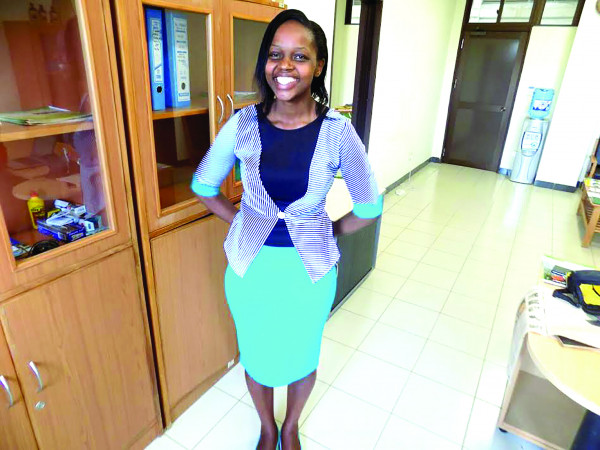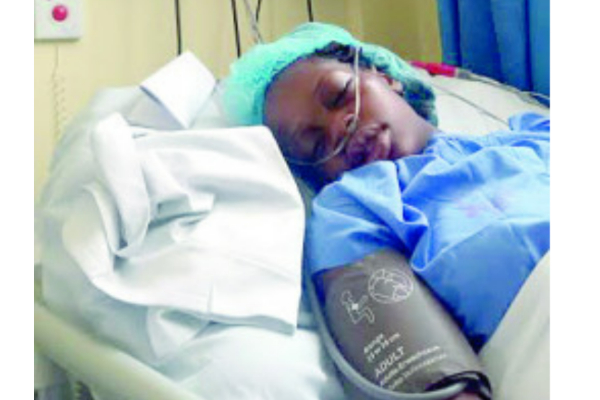Coerced or too posh to push? High C-section cases stir debate
By Kwach Wakhisi, September 19, 2022Four years ago when Rose Mumbi Wanyeki, 27, discovered she was expectant with her first child, she was excited and over the moon. She couldn’t wait to hold her bundle of joy and enjoy her journey into motherhood.
However, the events that led to the birth of her son left her incapacitated and since then, she can hardly do anything for herself. She depends on her husband to nurse her and take care of her as well as their young son.
“Things happened so fast that day. To this date, I have no recollection of what transpired, one minute I had gone to hospital to give birth and the next minute, I was waking up from a coma. It is my husband who narrates to me the events of that day,” Rose painfully recalls.

Induced against will
Rose went to hospital on her due date. “When I went to hospital, a private hospital in Thika, I was not in pain. As a first-time mother, I did not know that I needed to wait for labour pains to kick in before I could go,” she says.
She recalls a nurse approaching her and giving her a tablet and instructed her to put it under the tongue. She did not know she was being induced! “From there, I can’t recall anything. When my husband came to see me, he found me in the labour ward, alone and in pain. The nurses told him that they needed to take me to another room and after about 20 minutes, they told him that I had developed a complication, which necessitated an emergency caesarean section (C-section). Confused and also, a first-time father with little understanding of what was going on, he signed the consent form,” Rose explains.
Huge hospital bill
The events that followed saw Rose’s baby handed over to her husband at 3pm, slightly above four hours after she had been wheeled to theatre. He insisted to see her. “My husband says he came to the theatre and found the doctors trying to resuscitate me. I had slipped into a coma. I had to be transferred to Nairobi Women’s Hospital. In the report, the doctor didn’t say exactly what transpired,” she says.
At Nairobi Women’s Hospital, she was quickly received and taken to the Intensive Care Unit where she stayed for two weeks before she woke up. She was transferred to the general ward and was later discharged with a bill amounting to Sh1.3 million, which they are still struggling to pay to date.
Rose offers: “I was in a state of confusion, suffered memory loss and couldn’t feed on my own or walk. I really don’t know what happened to me that day. At the moment, I have been put on daily life-saving drugs-Rivotril, Nootropil, Tegretol and Folic Acid, which costs her Sh1,500 per day. If I don’t take the drugs, I can’t move an inch. The doctor said I should plan to go to India for proper treatment.”
Supportive partner
Rose now hopes for a miracle that will see her regain her health.
Rose’s case is part of a debate over the rising use of cesarean sections, which has increasingly been tied not only to maternal or foetal outcomes, but also to organisational imperatives.
When medically justified, a caesarean section can effectively prevent maternal and perinatal mortality and morbidity.
In Ursula Wanjala’s case, a marketing professional and a mother of two boys, her two C-section procedures were medically necessary. “When I was six months pregnant with my first child, I developed high blood pressure. And at 36 weeks, during a regular clinic my blood pressure had gone so high that I had to be admitted in hospital and put under observation,” says Ursula.
“I stayed in hospital for one week and the doctors were unable to stabilise the condition and fearing that the baby’s liver may get affected, they recommended an emergency C-section. I had never been so scared in my life! The fear of losing my baby or dying and leaving my baby without a mother was too much. On the night of admission, I developed difficulties in breathing, I thought I was going to die,” she adds.
She delivered her second baby through C-section because she had not spaced her babies far apart enough and she risked a ruptured uterus.
In July, a report released by the Ministry of Health indicated that the rate of C-section deliveries in Kenya is almost double the average for Africa and the prevalence of C-section has increased progressively from 14.5 per cent in 2017 to 16.4 per cent in 2021.
According to the report, the number of Kenyan women delivering babies via C-section has crossed the World Health Organization’s (WHO) recommended limit with the average C-section rate for Africa estimated at about 9.2 per cent.
Ursula thinks women have a lot of health issues, thus the many C-section cases. Sometimes it’s the food we eat or lack of exercise. Preeclampsia has also contributed to the increase.
WHO reports that C-section are absolutely critical to save lives in situations where vaginal deliveries would pose risks, but not all the surgeries are carried out are needed for medical reasons.
The Ministry of Health report observed that the Kenyan government’s campaign encouraging women to give birth in health facilities dubbed ‘Linda Mama’ has contributed to the high number of C-section, adding that the changing trend is not homogeneous across the country when compared across the 47 counties.
It further cautioned that some hospitals maybe taking advantage of vulnerable pregnant women, noting that part of the reason medics recommend caesarean sections is because they earn more money from them.
Dr Stephen Mutiso, a consultant obstetrician and gynaecologist at the Kenyatta National Hospital says many C-section are done for genuine reasons.
“We should be more concerned about the outcome of both the mother and baby rather than the rates. The C-section rate in the USA is 32 per cent while in the UK it is 25 per cent. The rate of nine per cent in Africa may mean that there are women who require C-section and get it,” says Dr Mutiso.
Vaginal births too, can be tragic
“C-section on request is now an acceptable indication as long as there is a discussion about related complications,” he adds.
He notes that in some instances, there are women who require a C-section, but don’t get it due to lack of facilities or accessibility challenges in terms of transport and cost, or cultural reasons.
“Vaginal birth, also referred to normal delivery, can sometimes turn very tragic with serious complications, such as uterine rupture, perineal tears, fistula and poor foetal outcomes, including death. The desire to keep the C-section rate low can be harmful to the mothers and babies. The C-section rates in Kenya reflect an improvement in maternity care in our country,” says the expert.
In private hospitals, for instance, C-section deliveries range between Sh100,000 and Sh300,000, while normal delivery is about Sh40,000 to Sh150,000. “The uptake of C-section is very high in private hospitals and in public facilities it is affordable with the introduction of the Linda Mama initiative,” says Erick Oyani Alwenda, an Obstetrician and Gynaecologist at Ndhiwa Sub-County hospital, Homa Bay County.
“In the case of an elective procedure, some women just fear the pain of delivering the normal way, want convenience and others fear the complications that sometimes arise from normal delivery, such as prolonged labour that can lean to fetal distress, among others,” adds the expert.
Unplanned C-section is when you were planning to have a vaginal birth, but a little while before your delivery your doctor decides that a C-section is best for you and your baby, and the Emergency C-section happens when delivery must occur urgently to make sure both you and baby are safe.
Since not all health facilities have the capacity to perform C-sections, health experts note that appropriate referral systems should be put in place to ensure mothers in need of the procedure can be transferred to high-level hospitals in times of emergency.
